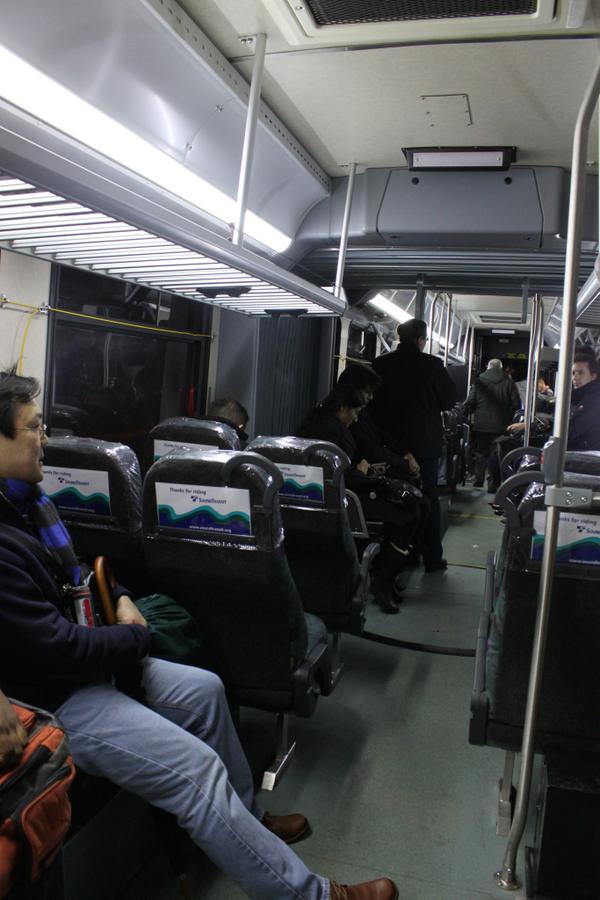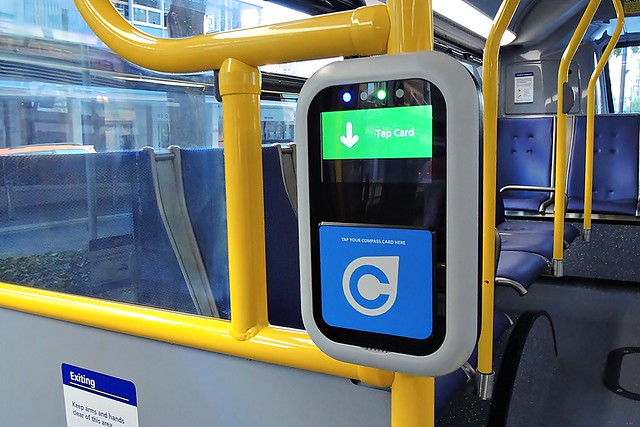A few simple onboard improvements to King County Metro buses could truly enhance the customer experience and increase their overall efficiency. Outfitting new and existing buses with the following feature enhancements would provide passengers more space, expedite the boarding and deboarding process, speed up overall bus service, reduce fuel consumption, and save service hours.
3 Ways to Make Improvements

1. Overhead baggage storage. Bags blocking the aisles or placed on otherwise usable seats—it happens all the time. Space is necessarily limited on buses, especially in a city where many passengers carry backpacks, purses, and groceries during their daily commute. Many Metro passengers also use transit as a primary mode for leisure travel across the region or connecting services to travel outside of the Puget Sound region. Needless to say, it’s unsurprising to see large suitcases and luggage on a normal bus trip.
Metro would be wise to deploy overhead baggage storage on all buses. Doing so would achieve greater capacity by reducing aisle blockage and seats filled with bags. Instead, more passengers could sit or stand aboard buses. Fewer obstacles in the aisles would reduce delays. Reasonably, fewer bags should be blocking aisles and passengers should become more mobile by “taking a load off.” This simple onboard feature also enhances passengers’ well-being and personal comfort.
Most of Sound Transit’s new fleet of New Flyer (and old Gilligs) buses are outfitted with overhead baggage storage—a great local example of how to implement storage racks without affecting aisle standing areas or passengers seated below.

2. Touch-responsive rear door sensors for exiting. “BACK DOOR!” A fellow passenger screams out to the driver—often to no avail—that they want to alight from the bus. Bus systems all over the United States have rear door technology that allows passengers to press their hands on the doors to exit (or some similar feature). Typically, a light or indicator becomes lit when the bus has come to a complete stop and the door is operable by pushing or touching it.
Implementing a touch-responsive rear door system would add convenience and a sense of freedom for passengers. There’s nothing worse than feeling trapped at the rear of the bus, and shouts of “back door” can be a nerve-racking and frustrating experience for any passenger. Not only would this feature save fellow passengers from the disturbing shouts to exit, but it would allow bus operators to focus their attention on other customer service duties toward the front of the vehicle. Pierce Transit is leading the way locally and has implemented the technology on all new buses.

3. Rear door boarding with ORCA readers. Passengers should not be limited only to front-door entry. By deploying ORCA readers, passengers could freely enter both front and rear doors. The key benefits are multiple entry options for riders, a faster boarding process, and drastically reduced bus dwell times. For instance, there are many times where a bus has to board or deboard a handicapped individual, a time consumptive process (even if there is passive restraint). Instead of all passengers waiting to board, they could simply board through an alternative door.
Metro mothballed rear door entry (if you discount the old Free Ride days) a few years ago because of implementation costs. ORCA readers don’t come cheap, and lack of a network-wide Proof of Payment (POP) system on regular bus routes poses a hurdle to implementation. Neither of these is insurmountable, but a cash-strapped Metro makes this a challenge for now. It is worth noting that RapidRide has been outfitted with POP. Fare enforcement officers are tasked with boarding buses to ensure that passengers have paid their fare.
Conclusion
The first two customer experience enhancements seem like fairly achievable goals. Overhead baggage storage racks aren’t cost prohibitive given that bus interiors are fairly flexible. Not every existing model is completely adaptable, but most of the recent buses types that Metro has acquired are. And, given that Metro has gone with New Flyer for essentially all new buses, the overhead baggage rack is a cheap and simple add-on. Touch-responsive rear door sensors for exiting is a bit more challenging. Depending upon bus type, this could be an easy retrofit (although not inexpensive) or a challenging one that requires significant new wiring and computer technology. Meanwhile, rear door boarding would require a policy change to allow rear door entry, significant capital expenditure to implement, and a more robust POP fare enforcement system. On the whole, though, each of these improvements would greatly improve the customer experience through faster buses, more space and comfort, and quicker boarding and deboarding.
Stephen is a professional urban planner in Puget Sound with a passion for sustainable, livable, and diverse cities. He is especially interested in how policies, regulations, and programs can promote positive outcomes for communities. With stints in great cities like Bellingham and Cork, Stephen currently lives in Seattle. He primarily covers land use and transportation issues and has been with The Urbanist since 2014.


